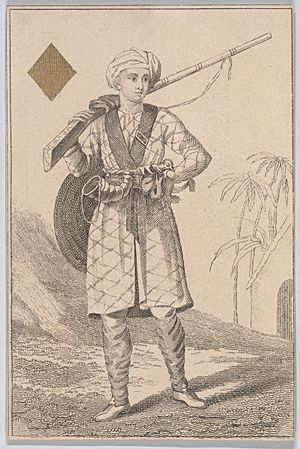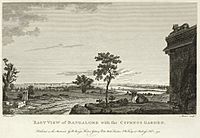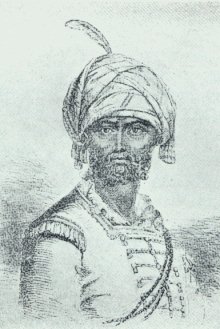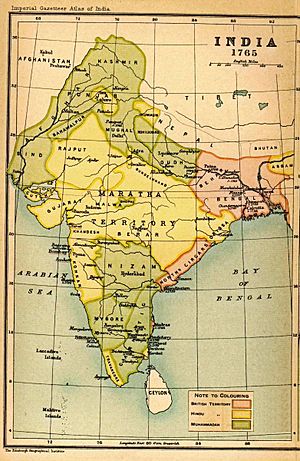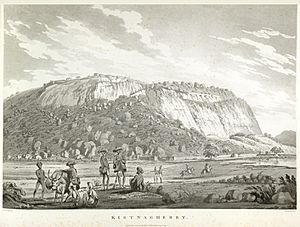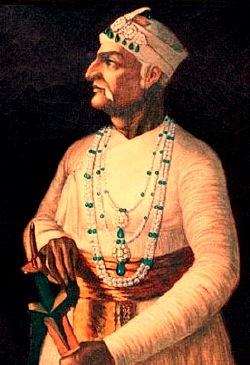Hyder Ali facts for kids
Quick facts for kids Hyder Ali |
|
|---|---|
| Nawab of Mysore Sarvadhikari of Mysore Dalavayi of Mysore Shams-ul-mulk Amir-ud-daulah |
|
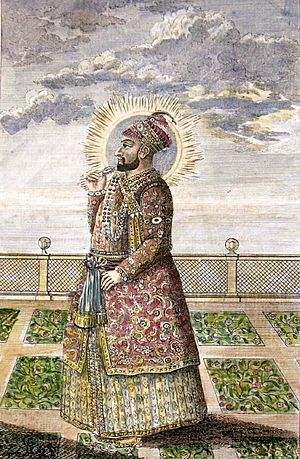
A 1790's steel engraving of Hyder Ali
|
|
| Sultan of Mysore | |
| Reign | 1761–1782 |
| Predecessor | Krishnaraja Wodeyar II (as Maharaja) |
| Successor | Tipu Sultan |
| Born | c.1720 Budikote, Kingdom of Mysore (modern-day Kolar, Karnataka, India) |
| Died | 7 December 1782 (aged 62) Chittoor, Sultanate of Mysore (modern-day Andhra Pradesh, India) |
| Burial | Srirangapatna, Karnataka 12°24′36″N 76°42′50″E / 12.41000°N 76.71389°E |
| Spouse | Fathima Fakhr-un-Nisa |
| House | Mysore |
| Father | Fath Muhammad |
| Mother | Lal Bi |
| Religion | Islam |
| Military career | |
| Allegiance |
|
| Service/ |
Mysore |
| Rank | |
| Battles/wars | Mughal-Maratha Wars Carnatic Wars Seven Years' War Mysore's campaigns against the states of Malabar (1757) Mysorean invasion of Kerala Maratha–Mysore War First Anglo-Mysore War Second Anglo-Mysore War |
Hyder Ali (born around 1720 – died December 7, 1782) was a powerful ruler of the Kingdom of Mysore in southern India. He started as a soldier and rose to become the actual leader of Mysore by 1761. He was known for his military skills and for fighting against the East India Company in the First and Second Anglo–Mysore Wars.
Even though Hyder Ali could not read or write, he was very smart. He made friends with the French and used their help to build up his army and weapons. His time as ruler was full of wars with his neighbors and small rebellions in his own lands. This was common in India at the time. When he died, he left a large kingdom to his son, Tipu Sultan.
Contents
- Hyder Ali's Early Life and Military Start
- Hyder Ali's Rise to Power
- Hyder Ali Becomes King of Mysore
- Hyder Ali Fights the Maratha Confederacy
- The First Anglo-Mysore War
- Connecting with Other Countries
- Second War with the Maratha Confederacy
- The Second Anglo-Mysore War
- Hyder Ali's Death
- Mysore's Navy
- Military Rocket Innovations
- Mysore's Economic Policies
- Hyder Ali's Family
- See also
Hyder Ali's Early Life and Military Start
Hyder Ali was born in Budikote, a place in the Kolar district of India. The exact year he was born is not fully known, but it was likely between 1717 and 1722. His father, Fath Muhammad, was a military commander for the rulers of Mysore. He was given land called a jagir in Budikote.
Hyder Ali joined the army with his brother, Shahbaz, after their father died in battle. They first served other rulers before coming to Srirangapatna. There, Hyder's uncle introduced them to the powerful ministers of the Kingdom of Mysore. Hyder and his brother were given commands in the Mysorean army. Hyder started with 100 cavalry (horse soldiers) and 2,000 infantry (foot soldiers).
Hyder Ali's Rise to Power
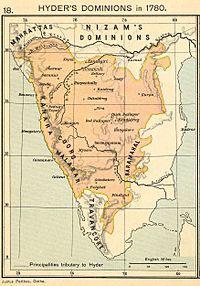
Gaining Experience in the Carnatic Wars
In 1748, a big war started in southern India called the Second Carnatic War. This war was about who would rule the region after the death of the Nizam of Hyderabad. Many local leaders, as well as French and British forces, were involved.
Hyder Ali and his brother fought bravely in these wars. They helped Mysore's army during a long siege at Devanhalli Fort. Because of their courage, they were given bigger commands in the army. By 1755, Hyder Ali commanded 3,000 foot soldiers and 1,500 horse soldiers. He also learned from French military experts, especially about how to use artillery (large cannons).
During these early wars, Hyder Ali learned to dislike Muhammed Ali Khan Wallajah, the ruler of the Carnatic. This ruler was allied with the British, and Hyder Ali felt he prevented any lasting peace with the British.
Hyder Ali's Clever Skills
Hyder Ali was very good with numbers, even though he couldn't read. He worked with a smart financial assistant named Khande Rao. Together, they created a system to keep track of all money and goods, even stolen ones, to prevent cheating. This smart way of managing money helped Hyder Ali become more powerful.
Taking Control of Srirangapatna
In 1757, Hyder Ali was called back to Srirangapatna, the capital of Mysore, because of threats from other kingdoms. He found the Mysorean army in chaos, with soldiers refusing to fight because they hadn't been paid. Hyder Ali made sure the soldiers were paid and stopped the rebellion.
For his actions, Hyder Ali was given control of Bangalore. By 1759, he was in charge of the entire Mysorean army. The young king, Krishnaraja Wodeyar II, gave him the special title of Nawab Hyder Ali Khan. This made him the first ruler of Mysore to be called Nawab.
Overcoming Challenges and Becoming Ruler
The ongoing wars had left Mysore's treasury empty. The queen mother tried to remove a powerful minister named Nanjaraj, which helped Hyder Ali gain more influence.
In 1760, the queen mother and Khande Rao tried to remove Hyder Ali from power. He was forced to leave Srirangapatna, leaving his family behind. However, a major defeat for the Marathas in a faraway battle in January 1761 helped Hyder Ali. The Marathas had to pull their forces out of Mysore.
Hyder Ali quickly gathered his strength. He got help from the exiled Nanjaraj and was given command of his army. Through a clever trick, Hyder Ali made Khande Rao's army believe they were being betrayed, causing Khande Rao to flee. Hyder Ali then took control of most of the army and surrounded Srirangapatna. After talks, Hyder Ali gained almost complete military control of Mysore. He imprisoned Khande Rao in Bangalore.
Hyder Ali Becomes King of Mysore
In 1761, Hyder Ali became the true ruler of Mysore. He took over from the prime minister and made the king, Krishnaraja Wodeyar II, a prisoner in his own palace. Hyder Ali began calling himself Sultan Hyder Ali Khan.
He was careful in his dealings with the Nizam of Hyderabad, who was considered the main Muslim ruler in southern India by the Mughal Emperor. The British and Marathas still called Hyder Ali and his son Tipu Sultan "Nabobs," which was a title for powerful Indian officials.
-
The flag of the Sultanate of Mysore at the entrance into the fort of Bangalore.
Expanding the Kingdom and Forming Alliances
Over the next few years, Hyder Ali expanded his kingdom to the north. He took Sira from the Marathas and the rich kingdom of Bednore. In 1763, he captured Bednore's capital, Ikkeri, which had a huge treasury. He renamed the capital Haidernagar and started using the title Hyder Ali Khan Bahadur. He moved his family to Ikkeri, a strong fortress.
Hyder Ali made sure his son Tipu received a good education. He was suspicious of foreigners and did not allow the East India Company to have a representative at his court.
Taking Bednore also gave him control of several ports on the Malabar coast, including Mangalore. Hyder Ali used these ports to create a small navy. He had good relationships with the Christian people in Mangalore and even allowed a Protestant missionary at his court. His army also included Christian soldiers, and he allowed a church to be built in Seringapatam.
Hyder Ali Fights the Maratha Confederacy
In 1761, the Maratha Empire was weak after a major defeat. Hyder Ali decided this was the time to attack them and end their threat to his power. He attacked the queen of Bednore, who was allied with the Marathas. The Marathas fought back with a strong army and defeated Hyder Ali near Rattihalli. Hyder Ali had to retreat and lost some of his gains, though he kept Sira. He also paid a large amount of money to end the war.
In 1766, Hyder Ali returned to the Malabar coast. He defeated the Zamorin of Kozhikode, who was an ally of the East India Company. Hyder Ali took control of Kozhikode and other smaller states in the region, making them part of Mysore. After a rebellion, Hyder Ali punished the rebels severely, executing many and moving thousands to the Mysorean highlands.
In April 1766, the king of Mysore, Krishnaraja, died. Hyder Ali made Krishnaraja's son the new king but kept all the real power for himself. He even had spies in the king's palace.
The First Anglo-Mysore War
The British, after winning the Battle of Buxar, decided to support the Marathas against Mysore. Hyder Ali had hoped the British would help him against the Marathas, but they did not.
In 1766, Mysore became involved in disputes between the Nizam of Hyderabad and the East India Company. The Nizam tried to get Hyder Ali to attack the Carnatic region. This led to the start of the First Anglo-Mysore War in August 1767. Hyder Ali's combined army with the Nizam was much larger than the British force, but they were pushed back.
Hyder Ali continued fighting, even during the monsoon season. He besieged Ambur in November 1767. The Nizam eventually made a separate peace treaty with the British in 1768, leaving Hyder Ali to fight alone. Hyder Ali tried to make peace with the British, but they refused.
In early 1768, the British attacked Mysore's Malabar coast. Hyder Ali's navy deserted, and the British captured Mangalore. This forced Hyder Ali to leave the Carnatic and quickly move to Malabar. He sent his son Tipu ahead and soon recaptured Mangalore and other ports from the British.
After taking back Mangalore, Hyder Ali believed the local Christians had helped the British. He considered punishing them severely but instead imprisoned those found guilty of treason. He then made an agreement with the Portuguese, which protected the clergy and other Christians. The Christian community in Mangalore thrived during the rest of his rule.
While Hyder Ali was in Malabar, the British recaptured many places in the Carnatic. They also convinced the Marathas to join the fight against Hyder Ali. Hyder Ali returned to Bangalore in August 1768 and tried to stop the British and Marathas from joining forces. He offered to pay a large sum for peace, but the British demanded too much.
Hyder Ali continued to fight bravely, even surprising a British garrison at Mulwagal. Despite heavy losses, he was a skilled tactician. The war ended with the Treaty of Madras on March 29, 1769. The treaty restored the lands to their original owners, except for Karur, which Mysore kept. It also stated that each side would help the other defend its territory.
Connecting with Other Countries
When Hyder Ali gained control of the Malabar coast, he used the ports to trade with countries overseas. He made trade rules that favored Mysorean and Arab traders over European ones. In 1770, he sent ambassadors to Muscat and Persia to seek military and trade alliances.
He also planned to send an ambassador to the Ottoman Sultan, but it was his son Tipu Sultan who later made direct contact with Istanbul.
Second War with the Maratha Confederacy
Hyder Ali believed the British would support him against the Marathas. He started demanding tribute from smaller states and refused to pay the Marathas. In November 1770, the Marathas invaded with a large army. The British refused to help Hyder Ali, so he retreated, burning crops and supplies to prevent the Marathas from using them.
The Marathas captured much of northeastern Mysore. Hyder Ali offered to pay some tribute, but it was rejected. The Marathas continued their attack, even besieging Seringapatam for five weeks before taking Bangalore. Hyder Ali again asked the British for help, but their demands were too high.
In 1772, Hyder Ali finally made peace. He agreed to pay a large sum in tribute and return most of the land he had gained, though he kept Sira. After the peace, Hyder Ali found out that the king of Mysore, Nanjaraja, had been secretly talking with the Marathas. Hyder Ali had Nanjaraja killed and put his brother Chamaraja on the throne.
The peace did not last long. In 1773, Hyder Ali took advantage of a power struggle among the Marathas. He sent Tipu to recapture lost territories and went himself to Coorg to secure a route to the Malabar coast. He quickly captured Coorg's capital and then recovered all his lost territory in Malabar by the end of 1774. The people of Coorg rebelled, but Hyder Ali crushed the rebellion.
In 1776, the young king Chamaraja Wodeyar VIII died. Hyder Ali chose a new king by watching the royal children play. He picked a child who chose to play with a jeweled dagger.
By 1775, the Marathas allied with the Nizam of Hyderabad against Hyder Ali. Hyder Ali's generals defeated the Maratha army in 1776, and he convinced the Nizam's leaders to withdraw. The conflict continued until 1779, and Hyder Ali expanded his kingdom to the Krishna River.
The Second Anglo-Mysore War
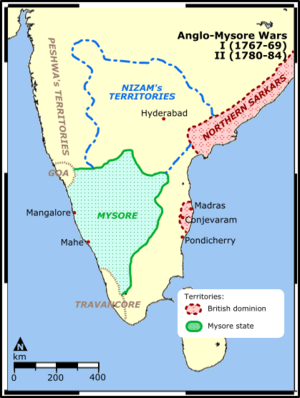
During his long war with the Marathas, Hyder Ali asked the East India Company for help several times, but they always refused. The British had also angered the Marathas and the Nizam of Hyderabad.
In 1779, the Marathas renewed their offer of an alliance with Hyder Ali and the Nizam. Hyder Ali decided to join this alliance because of two British actions. First, the British captured Mahé, a French port that Hyder Ali used for supplies. Second, British troops marched through his territory without permission.
Hyder Ali began rebuilding his navy in 1778. He hired a Dutchman, Joze Azelars, to build ships. The alliance planned to attack British holdings across India at the same time. However, the British convinced the Nizam and the Marathas not to fight, so Hyder Ali ended up fighting alone.
He did form alliances with local Muslim rulers and even met with Muslim Malays from Malacca.
-
A British illustration of Sayed Sahib leading Hyder Ali's forces during the Siege of Cuddalore.
-
The Battle of Pollilur, where Hyder Ali's forces used Mysorean rockets effectively against British troops.
-
Pierre André de Suffren was an ally of Hyder Ali.
-
Marquis de Bussy-Castelnau was an ally of Hyder Ali.
-
French Admiral Suffren (with Hyder Ali's help) aids Dutch forces against British Admiral Edward Hughes.
Hyder Ali's Attack on the Carnatic
Hyder Ali gathered a huge army, estimated at 83,000 soldiers. In July 1780, he swept down the Eastern Ghats, destroying the countryside. The British in Madras were unaware until they saw the fires of burning villages nearby. Hyder Ali besieged Arcot and sent his son Karim Khan Sahib to take Porto Novo.
When British forces moved to Kanchipuram, Hyder Ali lifted the siege of Arcot to confront them. He sent Tipu to intercept British reinforcements. Tipu and Hyder Ali surrounded the British force, forcing about 3,000 soldiers to surrender in the Battle of Pollilur on September 10. This battle was important because it was the first time rockets were used effectively in a major way. Hyder Ali then recaptured Arcot in November.
The British sent General Sir Eyre Coote from Bengal to lead their forces. Coote marched into the Carnatic and occupied Cuddalore.
Hyder Ali then moved into Tanjore, causing great destruction. He plundered the country, destroying crops and cattle. The economy of Tanjore dropped by 90% between 1780 and 1782. This period is remembered in local stories as the Hyderakalam, meaning "Hyder's time."
General Coote won a major victory against Hyder Ali at the Battle of Porto Novo on July 1, 1781. Hyder Ali lost an estimated 10,000 men. The two armies met again at Pollilur in August, where Hyder Ali was defeated again, though the battle was not decisive. Hyder Ali then besieged Vellore.
The British also learned they were at war with the Dutch. They captured the main Dutch port at Negapatam after a three-week siege in October and November 1781. This loss forced Hyder Ali to leave most of Tanjore.
In January 1782, General Coote again went to resupply Vellore. Hyder Ali did not stop him. In February, Hyder Ali sent Tipu to recapture Tanjore, where Tipu defeated a large British force. Hyder Ali also had to deal with rebellions in Coorg and Malabar.
On March 10, Hyder Ali learned that French forces had landed at Porto Novo. He immediately sent Tipu to meet them, and then followed himself. He met with the French Admiral Suffren, and they planned to make Cuddalore a French base. Cuddalore was taken without a fight in April. Hyder Ali and the French then marched towards Permacoil, which fell in May.
Hyder Ali's Death
Hyder Ali had been suffering from a cancerous growth on his back. He died in his camp on December 6, 1782. Some records say December 7. His advisors tried to keep his death a secret until his son Tipu could return from the Malabar coast.
When Tipu learned of his father's death, he immediately returned to take control. He had to stop an attempt by an uncle to put Tipu's brother on the throne. The British found out about Hyder Ali's death quickly, but their commander did not act fast enough to take advantage of it.
Hyder Ali was buried at the Gumbaz in Seringapatam, a special tomb built by his son Tipu Sultan.
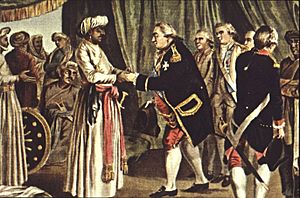
In 1763, Hyder Ali and Tipu Sultan started their first naval fleet on the Malabar Coast. It had 10 large boats called dhows and 30 smaller boats called ketches. This fleet helped them conquer islands.
Hyder Ali, like his son Tipu Sultan, protected foreign merchant ships. The Mysore navy even guarded Chinese merchant ships in the region. In 1768, Hyder Ali lost some ships in a fight with the East India Company. In 1775, two of his ketches attacked a British ship but were driven off. In 1780, the British attacked Hyder Ali's fleet again, causing much damage.
Military Rocket Innovations
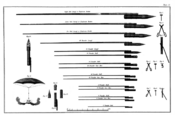
Hyder Ali was a pioneer in using rockets in warfare. These rockets were used against the East India Company during the Anglo-Mysore Wars. While rockets had been around for centuries, Hyder Ali improved them greatly. He used high-quality iron casings for the rockets, which allowed for stronger explosions. He also created special groups of soldiers who were skilled at aiming rockets based on their size and distance to the target. Rockets could also be mounted on carts, making them easier to move and fire many at once.
Hyder Ali's innovations led to new interest in rocket technology in Britain. British engineers, using ideas from Mysore, developed what became known as Congreve rockets in the early 1800s.
During Hyder Ali's time, the Mysorean army had a rocket corps of up to 1,200 men, which Tipu later increased to 5,000. In the 1780 Battle of Pollilur, one of Hyder Ali's rockets is thought to have hit a British ammunition store, helping to cause the British defeat.
Mysore's Economic Policies
The economy of Mysore was strongest under Hyder Ali and his son Tipu Sultan in the late 1700s. They started big plans to develop the economy and increase Mysore's wealth and income.
Hyder Ali's Family
Hyder Ali had at least two wives. His second wife, Fatima, was the mother of his famous son, Tipu Sultan, and another son named Karim. He also had a daughter.
|
See also
 In Spanish: Hyder Ali para niños
In Spanish: Hyder Ali para niños
- Husain Ali Khan Bahadur
- Mughal weapons
- Nawab of Savanur
- Arakkal Kingdom


